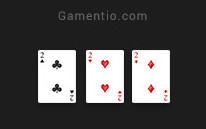Indian Rummy and Gin Rummy are the two most popular variants of Rummy world over. Since the rules to play Indian Rummy are very different from Gin Rummy, this blog attempts at unveiling all the differences that set the duo apart from each other.
Image source: www.13cardgames.com
-
Number of cards dealt to players
Indian Rummy: Indian Rummy is also called as 13 card Rummy because each player receives 13 cards. The game is played between at least two and maximum four players.
Gin Rummy: In Gin Rummy, each player receives 10 cards and only two players play the game.
-
Use of Joker cards
Indian Rummy: A joker card is used in Indian Rummy to complete a sequence of same suits or a set (cards of the same rank). In addition to two printed jokers, one more card is picked during the course of an Indian Rummy game and is used as the joker for the game.
Gin Rummy: Since there is no concept of joker in Gin Rummy, there are no rules as such to talk about.
-
Sets and sequences
Indian Rummy: The motive is to make suitable combinations of 4, 3, 3 and 3 cards. Two of the four combinations must be sequences and the remaining two could be straights. A joker card can be used to complete either a sequence or set. However, one of the sequences in 13 card Rummy must be a pure sequence, without a joker.
Gin Rummy: Gin Rummy requires three suitable combinations of 4, 3 and 3 cards. However, unlike Indian Rummy, all three combinations in Gin Rummy could be sets or sequences or both.
Examples of a pure sequence: Examples of a set:


-
When to ask for a show
Indian Rummy: A player can ask for a show in Indian Rummy after melding all the 13 cards in sets or sequences.
Gin Rummy: There are two options in Gin Rummy for a player to make a show. First is to meld all the 10 cards into sets and sequences. This kind of show is called go gin and the player wins 25 points.
The second way is called knocking. After a player melds almost all his/her cards and is left with the cards that are not part of combinations and have total value less than 10, the player can go for knocking. The cards not being melded are called deadwood cards. After a player knocks, the opponent has to lay off all his/her cards. The total points earned by the player who has knocked are based on the difference between his deadwood points and the opponent’s deadwood points. For example, if you have Ace, Four and Two, then your deadwood points are 7. Your opponent has Four, Five and King, his/her deadwood points are 19. The total points you win are 19 - 7= 12 points.
However, if your opponent’s deadwood points are less than yours, you are penalized with 25 points. In addition to 25 points, your opponent also earns the difference between your deadwood points and his/her deadwood points. So, if you knock and your deadwood cards are Ace, Two and Six and your opponent’s deadwood cards are Ace, Ace and Two. Your opponent earns 25 + (9 - 4) = 30 points.
In Gin Rummy, a player can also use the 11th card to fit in a combination ( both a set or sequence). Such a win is called Big Win in Gin Rummy.
-
Value of cards
Indian Rummy: In Indian Rummy, Aces can be used as both the first card and the 14th card. For example, Ace, Two and Three of same suit make a pure sequence and Ace, King and Queen of same suit also make a pure sequence.
Value of cards in Indian Rummy
| Cards | Value | Example 1 | Example 2 |
| Aces | 10 points | Ace of Spade = 10 points | Ace of Heart = 10 points |
| Faces | 10 points | Jack of Heart = 10 points | Queen of Diamond = 10 points |
| Others | Pip value | Six of Heart = 6 points | Eight of Club = 8 points |
Gin Rummy: In Gin Rummy, Aces are used as only the first card. So for a pure sequence, there could only be Ace, Two and Three of same suit, not Ace, King and Queen of same suit.
Value of cards in Gin Rummy
| Cards | Value | Example 1 | Example 2 |
| Aces | 1 point | Ace of Spade = 1 point | Ace of Heart = 1 point |
| Faces | 10 points | Jack of Heart = 10 points | Queen of Diamond = 10 points |
| Others | Pip value | Six of Heart = 6 points | Eight of Club = 8 points |
Indian Rummy and Gin Rummy are very popular among Rummy fans worldwide. Both the games have distinct rules, but keep players enthralled throughout the hands. I hope this blog has helped you understand the rules and nuances of the two most played games of Rummy.